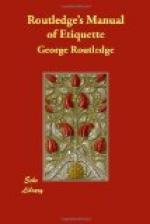We proceed to describe the step, so far as it may be possible to do so in words; but we have an uneasy consciousness that all such descriptions bear a close resemblance to those contained in certain little volumes designed to instruct our fair readers in the mysteries of knitting, netting, and crochet. “Slip two, miss one, bring one forward,” &c., may convey to the mind of the initiated a distinct idea of the pattern of a collar; but are hardly satisfactory guides to the step of a valse. We must, however, do our best; though again we would impress upon the reader the necessity of seeking further instruction from a professor or experienced friend.
The time of the Cellarius Valse is 3/4, like the common valse; but it should be played much more slowly; if danced quickly, it becomes an unmeaning succession of hops, and its graceful character is destroyed.
We describe the step as danced by the lady; for the gentleman it will be the same, with the feet reversed; that is, for right foot read left, and so on.
First Step.
1st and 2nd beat.—Spring on left foot, sliding forward right foot at the same time, and immediately let your weight rest on the forward foot. This occupies two beats.
3rd beat.—Spring on right foot; this ends the bar.
2nd bar, 1st and 2nd beat.—Spring again on right foot, and slide forward left at same time. Rest on it a moment as before during second beat; at third beat spring on it; which ends second bar. Continue same step throughout. You will perceive that, at the first and third beat of the time, you hop slightly, resting, during the second beat, on the foremost foot.
Second Step.
1st beat.—Spring on left foot, slightly striking both heels together.
2nd beat.—Slide right foot to the right, bending the knee.
3rd beat.—Bring left foot up to right foot with a slight spring, raising right foot; which ends the first bar.
2nd bar, 1st beat.—Spring again on left foot, striking it with heel of right.
2nd beat.—Slide right foot to the right.
3rd beat.—Fall on right foot, raising left foot behind it, which ends the second bar. Reverse the step by springing first on the right foot, and sliding the left, &c. The music generally indicates that this step should be repeated three times to the right, which occupies three bars; then rest, during the fourth bar, and return with reverse step to the left during the three bars which follow, resting again at the eighth bar.




